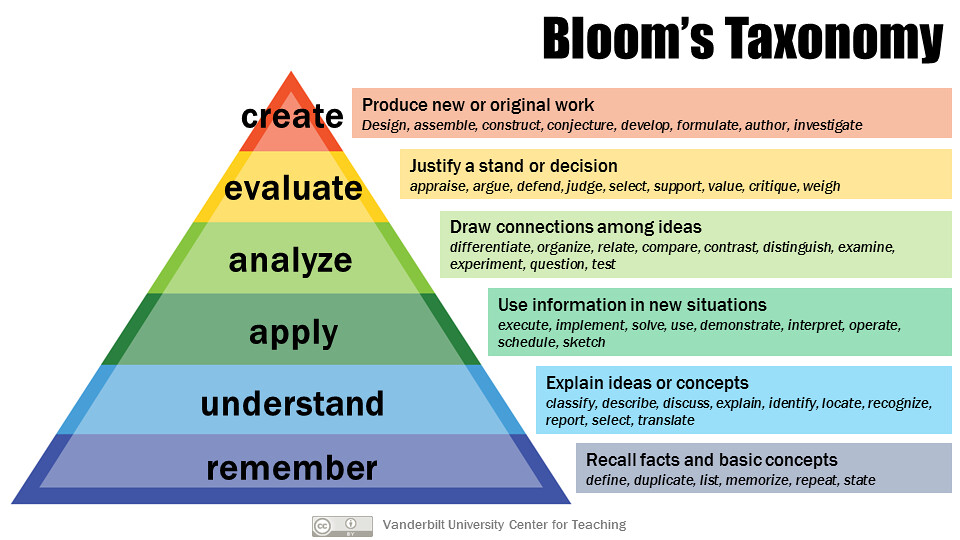Determining Learning Activities and Assessments

Learning activities encompass everything that students do in a course, the online and offline tasks and assignments. Whether students read a journal article, a textbook chapter, your lecture, write a paper or an essay, participate in a discussion, take a test, give a presentation, conduct a survey, do an observation, run an experiment and so on–these are all learning activities.
Learning activities that provide information on the student’s knowledge or skills to either the student or instructor. . Examples of an assessment are: a graded essay, a multiple-choice quiz that is automatically graded, a carefully crafted discussion forum that asks students to defend their opinion with research that demonstrates the learner has mastered a course objective.
Tony Anadio, 3/15/19: "Some Thoughts on Learning Styles"
Transcript
Designing Learning Activities
Before you set out to develop a course, you need to identify the outcomes, then plan out your learning activities and assessments within each module. At this stage, you might be asking some questions pertaining to the order in which the activities appear, their quantity, and pacing.
What to Consider
Sequencing

When considering the sequence of the learning activities for each module, think about answers to these questions:
What it is the learning outcomes?
How will the student demonstrate it?
What learning activities would help the student gain the knowledge/skill in order to demonstrate the way I want them to?
What prior konlwege does the student need and do they have that prior knowledge?
Does the information need to be sequenced/scafolled, etc?
Quantity

Some relevant questions to ask yourself when considering the quantity of the learning activities for each module are:
How many are needed to achieve the learning goal?
How much maintenance or elaborative rehearsal is required?
How much work do I expect from students in my traditional class? (You should expect the same quantity and quality of work from your online students as your classroom students.)
How many students will be in this class? (for example, depending on course objectives, your potential involvement in class discussions and the number of written assignments can fluctuate.)
What are the relative weights in terms of activity importance and how will the activities be evaluated?
Pacing

Some relevant questions to ask yourself when considering the pacing (or spreading) of the learning activities for each module are:
How long does it usually take students to accomplish a given task/activity?
Are there any issues specific to the online environment that would affect those expectations?
How long will it take the instructor to respond, give feedback, interact, etc. with students and their work?
Learning Activity Types
Generally speaking, we divide learning activities into two major categories – activities where learners are doing or observing something, and activities where learners reflect on the meaning of their learning. Below are some learning activities based on their typology as we see them most often in online courses.
|
Active Learning |
Reflective Learning |
Active AND Reflective |
|---|---|---|
|
Interview |
Blogging | Case study |
|
Game |
Self-check | Field study |
|
Collaborative project |
Journaling | Research paper |
|
Virtual world exploration |
Critique/Peer review | Whole/small group discussion |
|
Debate |
||
|
Short essay |
Assessment Types
Definition
Assessment is any activity that informs these questions:
- What are students learning?
- How well are they learning it?
Elements
Online students need the following:
- Clear statement of the learning goals and objectives.
- Appropriate feedback, focused on these goals, received early and often.
- Opportunities to assess their own learning.
- Clear statement of what will be measured and evaluated in their learning.
Types
Assessment for learning is often formative assessment , i.e. it takes place during the course of instruction by providing information that teachers can use to revise their teaching and students can use to improve their learning (Black, Harrison, Lee, Marshall & Wiliam, 2004). Formative assessment includes both informal assessment involving spontaneous unsystematic observations of students' behaviors (e.g. during a question and answer session or while the students are working on an assignment) and formal assessment involving pre-planned, systematic gathering of data. Assessment of learning is formal assessment that involves assessing students in order to certify their competence and fulfill accountability mandates. Assessment of learning is typically summative , that is, administered after the instruction is completed (e.g. a final examination in an educational psychology course). Summative assessments provide information about how well students mastered the material, whether students are ready for the next unit, and what grades should be given (Airasian, 2005).
Categories
Formative Assessments
Formative assessment typically occurs during and throughout instruction. When incorporated into classroom practice, it provides the information needed to adjust teaching and learning while they are happening. In this sense, formative assessment informs both instructors and students about student understanding at a point when timely adjustments can be made. These adjustments help ensure that students reach appropriate standards-based learning goals within a set time frame. Research suggests that most assessments should be formative in nature (Garrison & Ehringhaus, 2007).
Formative assessment benefits the students as it provides timely feedback to students which allows them to take ownership of their learning progress and to evaluate their progress towards learning goals.
Formal Formative Assessments
- Quick quiz
- Self assessment and reflection via logs, records, journals
- Graphic organizers, web or concept map
Informal Formative Assessments
- Observation
A growing body of research shows that formative assessment does improve learning when students understand the intended learning and the assessment criteria, when feedback to students is accurate and descriptive, provides information about how performance can be improved, and (most importantly) when students are actively involved with their own assessment. You should start thinking about how you will assess whether or not your students are understanding the concepts being taught.
Summative Evaluation
Summative assessment is assessment that typically occurs at the end of instruction to measure a student’s understanding of a subject. Typically, the student receives a mark or a grade for the purpose of making a final statement with regards to the student’s achievement and the effectiveness of instructional practices.
Examples of summative assessment include, but are not limited to:
- Standardized state exams
- Midterms or final exams
- End of unit tests
- Projects
- Performances
- Final copies
Asynchronous Discussions
Writing Online Discussion Questions
Writing effective discussion prompts and questions for online and blended courses can help your students engage more deeply with the course and enhance their interactions with one another.
Additionally, discussion forums offer several affordances:
- Students can craft their responses in a more thoughtful way than in a face-to-face classroom discussion.
- Students can complete write their posts at a time convenient to them.
- Discussions can be read and re-read, referenced, and archived.
Discussion prompts and questions should ask students to engage with content at the higher levels of Bloom’s Taxonomy, such as analysis, evaluation, interpretation, and creation (Ertmer, Sadaf & Ertmer, 2011; Greenlaw & Deloach, 2003).

https://cft.vanderbilt.edu/guides-sub-pages/blooms-taxonomy/ Creative Commons Attribution-NonCommercial 4.0 International License)
Points to Consider
- Determine the objective for the discussion activity first – then write the discussion questions(s)
- When the objective of the discussion is determined you can select the type of questions. There are many question types: Exploratory, Challenge, Relational, Diagnostic, Action, and Summary.
- Open-ended questions encourage students to support their answers with content from the course and outside resources
- Provide introductory text and suggested readings that help students to engage with the questions.
- Encourage students to incorporate their own experiences, which helps to further contextualize the material within the students’ prior learning (Hew & Cheung, 2012).
- Avoid more than 2 or 3 questions. Any more than that and the students lose focus of what is important and either they end up submitting mini-essays or they skip some of the prompts to keep the post short.
- Provide clear directions on how students should craft their response post and their responses to other posts – including any requirements for citing sources to support their writing.
Now that you have determined learning activities, move on to the next step: Selecting Content
Resources
Garrison, C., & Ehringhaus, M. (2007). Formative and summative assessments in the classroom
Deeper Learning Through Questioning https://lincs.ed.gov/sites/default/files/12_TEAL_Deeper_Learning_Qs_complete_5_1_0.pdf
Using Effective Questions
https://teaching.cornell.edu/teaching-resources/engaging-students/using-effective-questions
“Does your dog bite?” Creating Good Questions for Online Discussions
https://files.eric.ed.gov/fulltext/EJ1068072.pdf
Ertmer, P. A., Sadaf, A., and Ertmer, D. J. (2011). Student-content interactions in online courses: The role of question prompts in facilitating higher-level engagement with course content. Journal of Computing in Higher Education, 23(2-3), 157-186.
Greenlaw, S. A., and DeLoach, S. B. (2003). Teaching critical thinking with electronic discussion. Journal of Economic Education, 34(1), 36-52.
Hew, K. F., and Cheung, W. S. (2012). Student participation in online discussions: Challenges, solutions and future research. New York: Springer.
Howard, J. R. (2015). Discussions in the college classroom: Getting your students engaged and participating in person and online. San Francisco: Jossey-Bass.
Nathan Gonyea, Assessment: Basic Assessment Concepts. OpenStax CNX. Mar 26, 2012 http://cnx.org/contents/9741555b-741c-4f7c-b35c-5e4caded8121@1.Airasian, P. W. (2005). Classroom Assessment: Concepts and Applications (3rd ed). Boston, MA: McGraw Hill.
